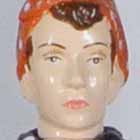T
Tanegashima
Guest
You really think the nikon crop is better than the sony in this one? What I think your trying to illustrate is the nikon has more detail? However, with all the noise in the J1 image, what do you think is going to happen to the so called "detail" when you apply any sort of noise reduction to the file in post. Bye, bye details. At least with the Sony file, working in RAW, you'd have a chance of pulling the details because there isn't the base luminance noise in the file. I don't really care too much about what a camera JPG engine does to a file, I care about what the RAW files look like. If the noise is that bad in the J1 files AFTER running through the in camera jpg engine, I can't imagine how bad they are in RAW with no NR applied...
And I'm also not 100% sure that part of what is going on in that photo is the result of the expand DOF in the J1 due to the small sized sensor. From the photo's I've seen from the 1 series on the web, the is basically no background blur on any image I've seen from these cameras, even wide open. The reason I say this is the bundles of thread on the NEX image appear soft on that image. These stick farther out into space than any other thing in the still life (At f/10 this surprises me a little bit, and I'm not 100% sure it's the right answer.) Yet the text on the grey board behind that is sharp on the NEX image. However, you look at the head of the Rosie the Riveter, it appears sharper on the NEX image.
NEX

J1

Edit: If you look at Amazon's top 100 DSLR's, the NEX-7 (with the kit lens) is the top selling mirrorless right now trending upwards in the mid teens (14 when I posted this). The NEX-7 body only is trending up in the low 20's, two versions of the NEX-5n are in the mid to high 20's. The first 1 series offering is the V1 two lens kit in the mid to high 30's with the 1 lens kit is 1 spot lower. In just 6 short days, the J1 has fallen out of the top 100. There are 9 different NEX offerings in the top 100, compared to 3 Nikon 1 series offerings. It looks like lots of people had waited to see what Nikon had up it's sleeve and have decided to pass in favor of the NEX system. Nikon 1 Series = too little, too late.
Nikon J1 is 10MP, NEX5 isn't.
Nobody's saying that Sony is better or worse. It's just you comparing the Nikon 1 to the NEX5, and you got what it is.
No, what you'll get will be jagged contours.you'd have a chance of pulling the details because there isn't the base luminance noise in the file.
Luminance noise isn't a problem at all… :loco:
Who said you that it passed some kind of NR?If the noise is that bad in the J1 files AFTER running through the in camera jpg engine
Whatever, it has more details than the Sony's, look at the color strings, Sony looks like a p&s camera.
Last edited by a moderator:
